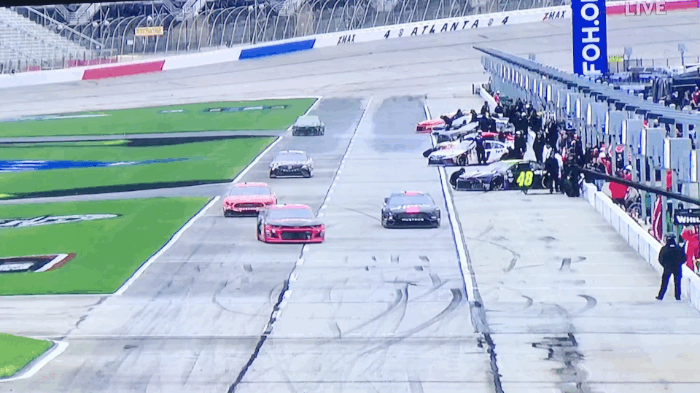Jimmie Johnson thinks it's 'weird timing' for NASCAR's qualifying pit road speed rule

Jimmie Johnson agrees with NASCAR’s decision to enforce pit road speed during qualifying. He just wonders why the rule was just put in place this week.
NASCAR announced Wednesday that it would mandate that cars adhere to pit road speed limits when driving out onto the track for qualifying laps. The move comes ahead of the fifth race of the 2019 season and a few weeks after a close call at Atlanta between Clint Bowyer and Austin Dillon.
As Bowyer and Dillon were racing off pit road for track position during qualifying at Atlanta, Dillon tried to block Bowyer. And Bowyer came a little too close to a NASCAR official standing on the end of pit road.

But instead of immediately instituting a pit road speed rule after that incident, NASCAR waited a few more weeks.
“It’s a logical rule change,” Johnson said. “It’s just kind of weird timing in my opinion. We’re packing our bags and getting ready to head to Fontana and we’re five races into the year and rule comes. I’m like what? Why didn’t we start the year like this? Again, it’s a logical rule. I still look forward to speaking with them today and trying to understand if it’s just to keep the cars at a controlled pace where there are men on pit road walking, or are they trying to create something different and keep us from maybe leaving the end of pit road in these big groups together.”
The groups Johnson references could be a reason why NASCAR waited to make the change. At Las Vegas the week after Atlanta, drivers scrambled to take to the track at the optimal distance behind each other during the group qualifying session because of NASCAR’s new rules on intermediate tracks.
If a driver wasn’t close enough to the car ahead of him he didn’t get a draft effect. If he was too close he risked losing the necessary amount of aerodynamic downforce on the front of his car and losing speed.
Johnson: My heart rate was lower at Vegas than Phoenix
Johnson also offered some interesting observations about his heart rate from the Las Vegas race weekend. Johnson, a fitness buff who is training for the Boston Marathon, has been keeping track of his heart rate in the race car in recent seasons and said his heart rate was considerably lower at Las Vegas than it was a week ago at Phoenix, where Cup cars had 200 more horsepower.
“So, like at Vegas, I guess our corner speed was a little bit higher but it was tough to feel it,” Johnson said. “We’re so used to working the pedals and being very concerned about your arc into the corner. How you work the pedals and the arc into the turn makes either easy or difficult and your heart rate follows that and your stress level through your body follows that. At Vegas you’d get all the way to the center of the turn and you’re like oh, I guess I am going kind of fast. And then you’re off the corner and you’re like, well, the only place that got my attention was for about four car length’s worth in the center of the corner. And it was all pretty calm.”
“And if you look at like my Strava account and follow my heart race, at Vegas it was like 120 or 125. Last weekend in Phoenix, having the power that we’re used to having, the whole corner you’re on edge and the stress level and g-forces are higher and I averaged at 155 beats a minute. So, it’s a good 30 beats a minute from 500 horsepower to 750 horsepower.”
– – – – – – –
Nick Bromberg is a writer for Yahoo Sports.
More from Yahoo Sports:


